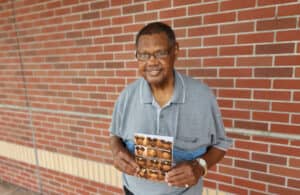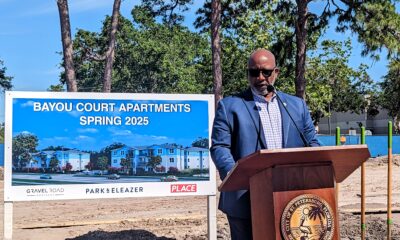Create
Vintage St. Pete: The Courageous Twelve

What the St. Petersburg Police Department did was to superimpose on natural geographic zones an artificial zone that rests on the Department’s judgment of Negroes as a class. The Department concluded that Negroes as a class are suitable only for the zone appropriately numbered 13. This is the kind of badge of slavery the thirteenth amendment condemns.
U.S. Court of Appeals for the Fifth Circuit/August 1, 1968
And thus BAKER et al., Plaintiffs, v. CITY OF ST. PETERSBURG came to an end, in favor of the plaintiffs – all 12 Black uniformed officers of the St. Petersburg Police Department.
They sued in 1965, the year after President Lyndon B. Johnson signed the Civil Rights Act into law, because they believed the city was still operating under the unspoken Jim Crow guidelines of an earlier era, when equality, sadly, meant different things to different members of society.
Black officers were only allowed to patrol the area known as Zone 13 – encompassing the Deuces (22nd Street South), the Gas Plant, Methodist Town and what was left of Pepper Town, the city’s first Black settlement.
Black neighborhoods.
Neither could Black officers arrest white suspects, wherever they might be apprehended. They could detain them, put in a call and wait for a white officer (there were 250 of them) to make the collar.
The reason, (white) Chief of Police Harold Smith said, was simply that Black officers could “do a better job” in Black neighborhoods.
No, it’s racial discrimination, pure and simple, cried the officers, adding that they were routinely given raggedy old cruisers to drive, while the Caucasian cops always seemed to get the new cars. And their lockers were all located in a row together, implying, they claimed, that were “equal, but separate.”
Today, we know them as the Courageous Twelve, and their story represented a major breakthrough in race relations not only on a local level, but across the entire country. They were the first to speak out. And the first to act.
Concluded the U.S. Court of Appeals: Nothing we say is intended to suggest that the Negro officers on the police force of St. Petersburg should be given preferential treatment. They deserve only what they seek — equality.
Says St. Petersburg Police Chief Anthony Holloway: “They really changed the face of law enforcement. They put their careers on the line so that people like me were able to move up in the law enforcement community. That meant a lot to all of us – not just St. Pete, but nationwide.”

Leon Jackson was the youngest member of the Courageous Twelve. At 82, he is the last survivor. Photo: Bill DeYoung.
Leon Jackson, 82, is the last surviving member of the Courageous Twelve. He was the youngest of the group, most of whom grew up in St. Petersburg, graduated from Gibbs High School and were proud to be civil servants.
Of course, suing their employer was a risky move. “We knew what we were getting into,” Jackson says. “We knew we could have been fired. But somebody had to take the chance to change the system.”
It would have been easier to keep their mouths shut, just as police officers in other cities were surely doing. “All of us were scared. We could have lost our homes. We could have lost our jobs. Our bills wouldn’t get paid. We’d be out looking for work. And they could have blackballed us out of law enforcement.”
They began to meet, just the 12 of them, in one another’s homes. “And out of one of those meetings,” Jackson recalls, we said ‘Look, let’s request a meeting with the chief, and discuss it with him.’ So the chief met with us twice – and of course he didn’t do anything about our complaints. We requested a third meeting, and he refused to meet with us any more.”
Was that to be the end of it?
“Our theory was that he wasn’t going to change. When he met with us, the only thing he would say was ‘I’ll get back with you guys.’ But he didn’t give any concrete reason for it, or say if he was going to make any changes.”
The frustrated officers then consulted attorney James B. Sanderlin, who’d been working civil rights cases locally for several years. Jackson: “Freddie Crawford was our leader, and he said ‘Let’s sue ‘em.’ We told Freddie ‘Look, man, you’re putting us on the spot. We could get suspended, or even fired.’ And Freddie was, I don’t want to say militant, but he was very steadfast. And he said ‘I don’t care. Let’s file a lawsuit. The chief’s not going to do anything.’”
A potential silver lining was discussed. “One of the officers – I don’t recall who – said ‘You know, the colored people are not going to stand for them firing us … but if they fire us, so be it.’”
Someone asked if maybe they should think it over before voting. “And Officer Charles Holland said “There’s nothing to think about.’ So we voted, right then and there. And all 12 of us agreed.”
 Sanderlin filed the suit May 12, 1965 in Federal District Court in Tampa. Defendants named were Police Chief Smith and City Manager Lynn Andrews. It cited discrimination in the areas of work assignments, promotion and pay, disciplinary procedures and use of dressing room facilities.
Sanderlin filed the suit May 12, 1965 in Federal District Court in Tampa. Defendants named were Police Chief Smith and City Manager Lynn Andrews. It cited discrimination in the areas of work assignments, promotion and pay, disciplinary procedures and use of dressing room facilities.
“We could not work any desk job inside the station,” Jackson recalls. “We could not even take the sergeants’ exam for a promotion.”
Police sergeant Sam Jones, who was Black, “could only supervise the African-American officers,” Jackson says. “He could not supervise the white officers.”
Jones and two detectives were the only other Black police department employees. All three declined to join the uniformed officers in their litigation.
The 12 had no issues with white officers, explains Jackson. For the most part, at least on the record, everyone got along great.
But the Black officers didn’t discuss the lawsuit with their white counterparts. “To them, it would be a sensitive subject. Some of them wouldn’t accept it. And some of them, not all, felt that we were against them – but we were not. We were against the system.
“One Caucasian police officer, his name was Bob Stokes, he went to federal court and testified that we were treated separately from the white officers. He supported us.”
In March, 1966, a federal district judge sided with the city and dismissed the case; Sanderlin, with the added support of the NAACP, both publicly and financially, appealed.
Not long before the appeals court overturned the lower verdict, Chief Smith began to quietly make changes. To show the community, Jackson believes, that the department was listening.
Jackson was the first officer assigned to patrol a traditionally white neighborhood – Snell Isle and Shore Acres. On the midnight-to-dawn shift.
“My theory is that they chose those neighborhoods because that’s where the more educated whites lived,” says Jackson, “and the wealthy whites. And they felt they would accept me more. And I didn’t have any problems.”
Once the appeal passed, change came slowly – but indeed it came. “After the appeal, they had to do it. Officer Raymond DeLoach went to work on the front desk. And I think the city attorney probably told them to do that, to show people there was a change.”
Jackson left the force in 1972 and went on to a lengthy career in windshield-film technology. Several others followed similar career trajectories.
Officer Horace Nero was promoted to sergeant, and officers Raymond DeLoach, Johnnie B. Lewis, Primus Killen and Charles Holland made detective.
James Sanderlin became Pinellas County’s first African-American judge.
In 2007, St. Petersburg Times reporter Jon Wilson wrote a story, “Pioneering policemen,” and Jackson, who had all but forgotten about the case, took it upon himself to bring all the survivors together.
“Once it hit the news media, it went like wildfire,” he remembers. The Courageous Twelve were profiled in newspapers and on TV news shows the world over – even Al Jazeera wrote about them. They were honored at an NAACP banquet, given the keys to the City of St. Petersburg and celebrated at the Carter G. Woodson Museum.

Oct. 29, 2019: From left Jonathan Styles (son of Officer Jerry Styles), Officer Leon Jackson, Tatiana Killen (daughter of Officer Primus Killen) and Chief Anthony Holloway dedicate the plaque honoring the Courageous Twelve at SPPD headquarters. Photo: St. Petersburg Police Department.
As the last survivor, Jackson was Grand Marshall of the city’s Martin Luther King Jr. parade, and was present when a plaque honoring the Courageous Twelve was unveiled by Chief Holloway at the new St. Pete Police Headquarters. He subsequently authored a book, Urban Buffalo Soldiers: The Story of St. Petersburg’s Courageous Twelve.
He is justifiably proud, and honored that, as the last man standing, he gets to tell the world about what he and his friends accomplished.
“We didn’t think we were making history,” Jackson says. “We didn’t think we were setting the bar. We didn’t think we were opening the doors for others. We wanted to change that system.”

Rendering of artist Ya La’Ford’s Courageous Twelve monument in the courtyard of Orange Station, the condominium/retail project rising on the site of the old St. Pete police headquarters under. Image provided.
THE COURAGEOUS TWELVE
Adam Baker
Freddie L. Crawford
Raymond L. DeLoach
Charles Holland
Leon Jackson
Robert V. Keys
Primus Killen
James King
Johnnie B. Lewis
Horace Nero
Jerry Styles
Nathaniel L. Wooten








KAREN J. DOUGLAS
November 19, 2022at6:14 pm
Thanks for a great article….